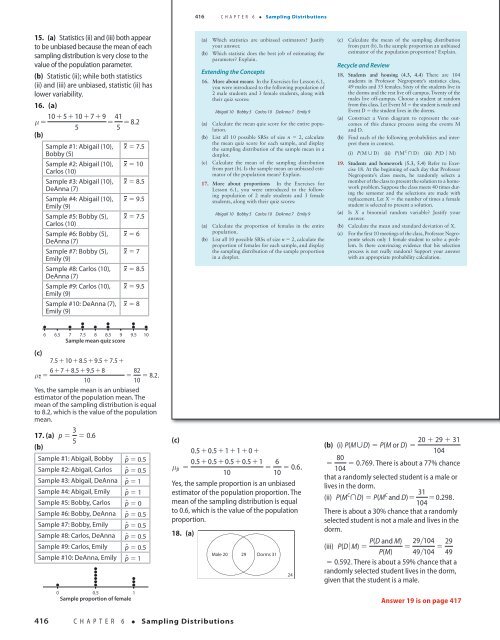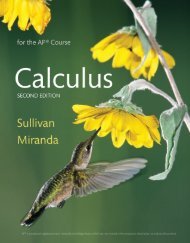SPA 3e_ Teachers Edition _ Ch 6
You also want an ePaper? Increase the reach of your titles
YUMPU automatically turns print PDFs into web optimized ePapers that Google loves.
416<br />
C H A P T E R 6 • Sampling Distributions<br />
15. (a) Statistics (ii) and (iii) both appear<br />
to be unbiased because the mean of each<br />
sampling distribution is very close to the<br />
value of the population parameter.<br />
(b) Statistic (ii); while both statistics<br />
(ii) and (iii) are unbiased, statistic (ii) has<br />
lower variability.<br />
16. (a)<br />
10 + 5 + 10 + 7 + 9 41<br />
m =<br />
=<br />
5<br />
5 = 8.2<br />
(b)<br />
Sample #1: Abigail (10), x 5 7.5<br />
Bobby (5)<br />
Sample #2: Abigail (10), x 5 10<br />
Carlos (10)<br />
Sample #3: Abigail (10), x 5 8.5<br />
DeAnna (7)<br />
Sample #4: Abigail (10), x 5 9.5<br />
Emily (9)<br />
Sample #5: Bobby (5), x 5 7.5<br />
Carlos (10)<br />
Sample #6: Bobby (5), x 5 6<br />
DeAnna (7)<br />
Sample #7: Bobby (5), x 5 7<br />
Emily (9)<br />
Sample #8: Carlos (10), x 5 8.5<br />
DeAnna (7)<br />
Sample #9: Carlos (10), x 5 9.5<br />
Emily (9)<br />
Sample #10: DeAnna (7), x 5 8<br />
Emily (9)<br />
(c)<br />
d d d<br />
d<br />
d d d d d<br />
6 6.5 7 7.5 8 8.5 9 9.5 10<br />
Sample mean quiz score<br />
m x =<br />
7.5 + 10 + 8.5 + 9.5 + 7.5 +<br />
6 + 7 + 8.5 + 9.5 + 8<br />
10<br />
= 82<br />
10 = 8.2.<br />
Yes, the sample mean is an unbiased<br />
estimator of the population mean. The<br />
mean of the sampling distribution is equal<br />
to 8.2, which is the value of the population<br />
mean.<br />
(a) Which statistics are unbiased estimators? Justify<br />
your answer.<br />
(b) Which statistic does the best job of estimating the<br />
parameter? Explain.<br />
Extending the Concepts<br />
16. More about means In the Exercises for Lesson 6.1,<br />
you were introduced to the following population of<br />
2 male students and 3 female students, along with<br />
their quiz scores:<br />
Abigail 10 Bobby 5 Carlos 10 DeAnna 7 Emily 9<br />
(a) Calculate the mean quiz score for the entire population.<br />
(b) List all 10 possible SRSs of size n 5 2, calculate<br />
the mean quiz score for each sample, and display<br />
the sampling distribution of the sample mean in a<br />
dotplot.<br />
(c) Calculate the mean of the sampling distribution<br />
from part (b). Is the sample mean an unbiased estimator<br />
of the population mean? Explain.<br />
17. More about proportions In the Exercises for<br />
Lesson 6.1, you were introduced to the following<br />
population of 2 male students and 3 female<br />
students, along with their quiz scores:<br />
Abigail 10 Bobby 5 Carlos 10 DeAnna 7 Emily 9<br />
(a) Calculate the proportion of females in the entire<br />
population.<br />
(b) List all 10 possible SRSs of size n 5 2, calculate the<br />
proportion of females for each sample, and display<br />
the sampling distribution of the sample proportion<br />
in a dotplot.<br />
(c) Calculate the mean of the sampling distribution<br />
from part (b). Is the sample proportion an unbiased<br />
estimator of the population proportion? Explain.<br />
Recycle and Review<br />
18. Students and housing (4.3, 4.4) There are 104<br />
students in Professor Negroponte’s statistics class,<br />
49 males and 55 females. Sixty of the students live in<br />
the dorms and the rest live off campus. Twenty of the<br />
males live off-campus. <strong>Ch</strong>oose a student at random<br />
from this class. Let Event M 5 the student is male and<br />
Event D 5 the student lives in the dorms.<br />
(a) Construct a Venn diagram to represent the outcomes<br />
of this chance process using the events M<br />
and D.<br />
(b) Find each of the following probabilities and interpret<br />
them in context.<br />
(i) P(M c D) (ii) P(M C d D) (iii) P(D k M)<br />
19. Students and homework (5.3, 5.4) Refer to Exercise<br />
18. At the beginning of each day that Professor<br />
Negroponte’s class meets, he randomly selects a<br />
member of the class to present the solution to a homework<br />
problem. Suppose the class meets 40 times during<br />
the semester and the selections are made with<br />
replacement. Let X 5 the number of times a female<br />
student is selected to present a solution.<br />
(a) Is X a binomial random variable? Justify your<br />
answer.<br />
(b) Calculate the mean and standard deviation of X.<br />
(c) For the first 10 meetings of the class, Professor Negroponte<br />
selects only 1 female student to solve a problem.<br />
Is there convincing evidence that his selection<br />
process is not really random? Support your answer<br />
with an appropriate probability calculation.<br />
17. (a) p = 3 5 = 0.6<br />
(b)<br />
Sample #1: Abigail, Bobby p^ 5 0.5<br />
Sample #2: Abigail, Carlos p^ 5 0.5<br />
Sample #3: Abigail, DeAnna p^ 5 1<br />
Sample #4: Abigail, Emily p^ 5 1<br />
Sample #5: Bobby, Carlos p^ 5 0<br />
Sample #6: Bobby, DeAnna p^ 5 0.5<br />
Sample #7: Bobby, Emily p^ 5 0.5<br />
Sample #8: Carlos, DeAnna p^ 5 0.5<br />
Sample #9: Carlos, Emily p^ 5 0.5<br />
Sample #10: DeAnna, Emily p^ 5 1<br />
d<br />
d<br />
d d dd d d<br />
0 0.5 1<br />
Sample proportion of female<br />
Starnes_<strong>3e</strong>_CH06_398-449_Final.indd 416<br />
(c)<br />
0.5 + 0.5 + 1 + 1 + 0 +<br />
0.5 + 0.5 + 0.5 + 0.5 + 1<br />
m p^ =<br />
= 6<br />
10<br />
10 = 0.6.<br />
Yes, the sample proportion is an unbiased<br />
estimator of the population proportion. The<br />
mean of the sampling distribution is equal<br />
to 0.6, which is the value of the population<br />
proportion.<br />
18. (a)<br />
Male 20 29 Dorms 31<br />
24<br />
20 + 29 + 31<br />
(b) (i) P(M c D) = P(M or D) =<br />
104<br />
= 80 = 0.769. There is about a 77% chance<br />
104<br />
that a randomly selected student is a male or<br />
lives in the dorm.<br />
(ii) P(M C d D) = P(M C 31<br />
and D)=<br />
104 = 0.298.<br />
There is about a 30% chance that a randomly<br />
selected student is not a male and lives in the<br />
dorm.<br />
P(D and M)<br />
(iii) P(D 0 M) = = 29∙104<br />
P(M) 49∙104 = 29<br />
49<br />
= 0.592. There is about a 59% chance that a<br />
randomly selected student lives in the dorm,<br />
given that the student is a male.<br />
Answer 19 is on page 417<br />
18/08/16 5:00 PMStarnes_<strong>3e</strong>_CH0<br />
416<br />
C H A P T E R 6 • Sampling Distributions<br />
Starnes_<strong>3e</strong>_ATE_CH06_398-449_v3.indd 416<br />
11/01/17 3:54 PM




